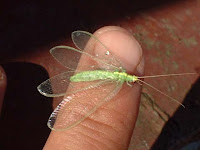Cultural Control – Quarantine and Inspection is important to prevent/control infestations. The twospotted spider mite, for example, is often introduced on infested bedding and house plants. When purchasing new plants, whether for outside plants or inside house plants, carefully inspect the new material for any signs of mite activity.
Examine most thoroughly the lower leaf surfaces and where leaves branch from the stem. New house plants should be quarantined from other plants until you are sure that no mites are present.
A forceful jet of water from a hose can wash mites from plants. Periodical washing can keep spider mites under control on most ornamental plants in the landscape. This technique also helps conserve natural predators. House plants can be relocated outside for treatment of twospotted spider mites and returned as soon as dried.
Biological Control – Predators.
There are numerous insects (lacewings and lady beetles) that prey on spider mites. However, the most common predators are other types of predatory mites. Predatory mites can be purchased and released onto infested plants. Some species are host specific and each predator works better under different weather conditions. If predators are used, help insure a favorable environment for them to prosper, including avoiding application of pesticides that will kill them.
Chemical Control - Most spider mites, if detected early, can be controlled with insecticidal oils and soaps. Horticultural oils can be used on perennial and woody ornamentals during the summer at the 1 to 2 percent rate. Higher rates of horticultural oil (3 to 4 percent) or dormant oil are useful for killing mite eggs and dormant adults in the fall and spring. Spring applications of dormant oils seem to be the most effective on cool season mites. Insecticidal soaps are most useful in warmer weather. Soaps and oils work by contact only and have no residual activity so thorough coverage of the plant is necessary for good control.








